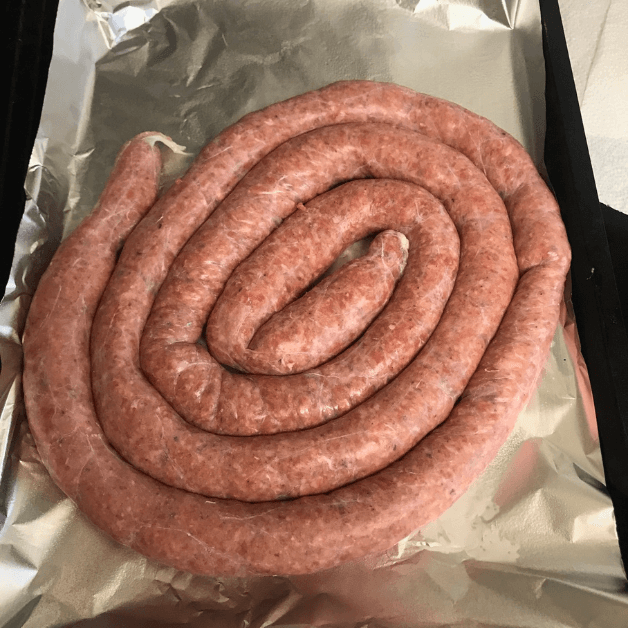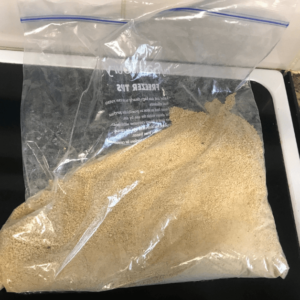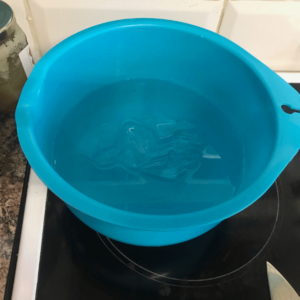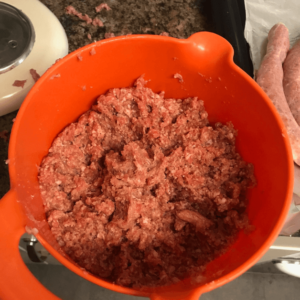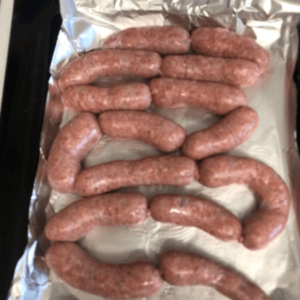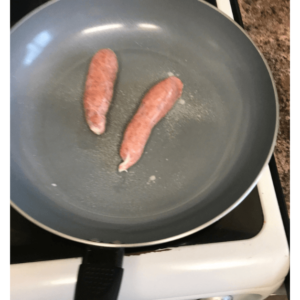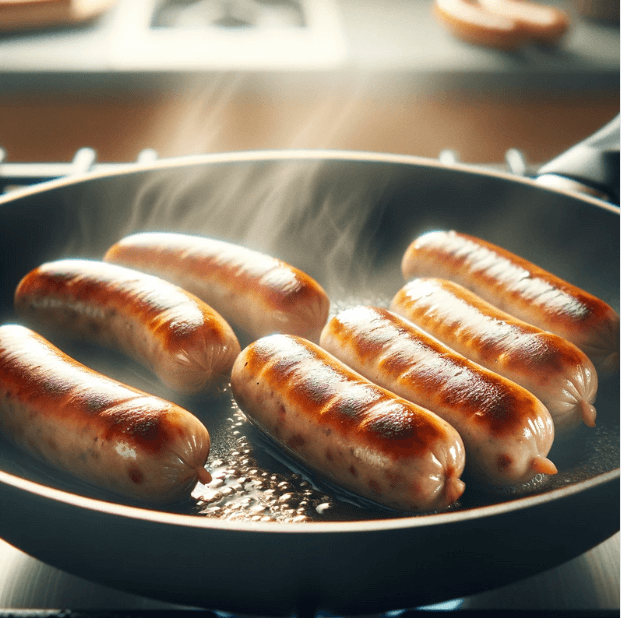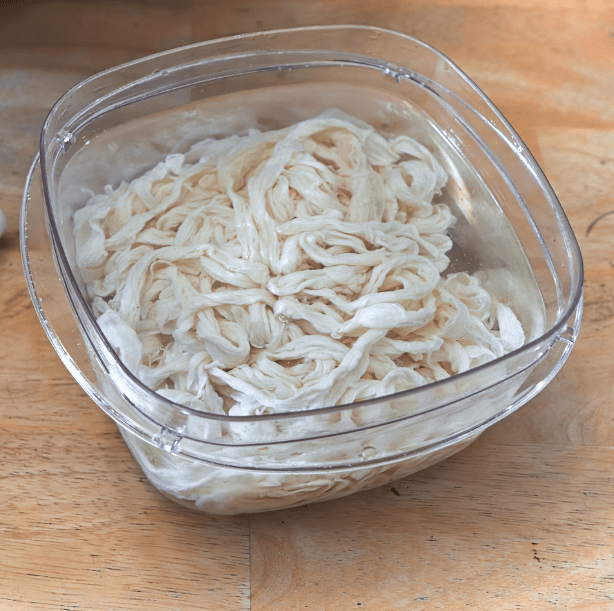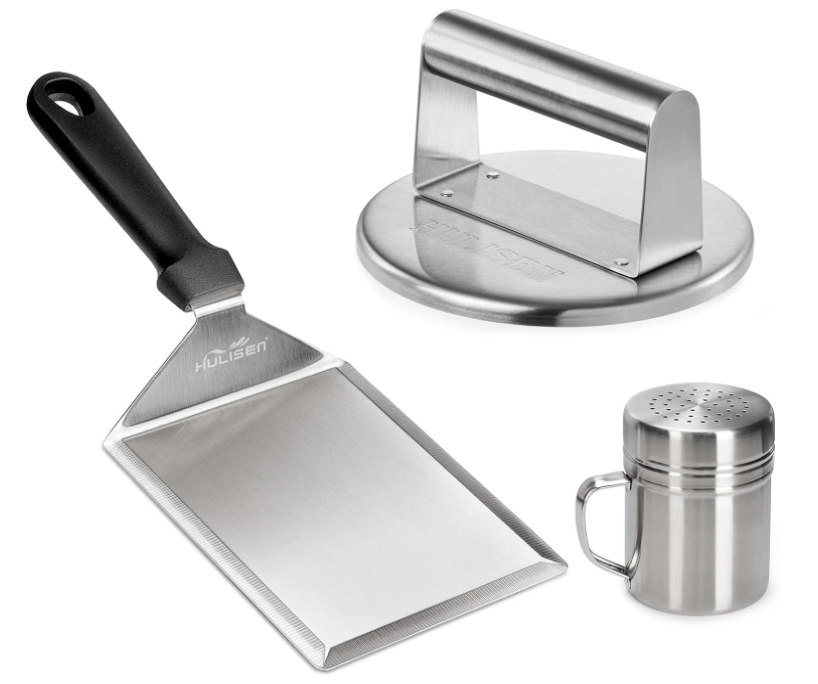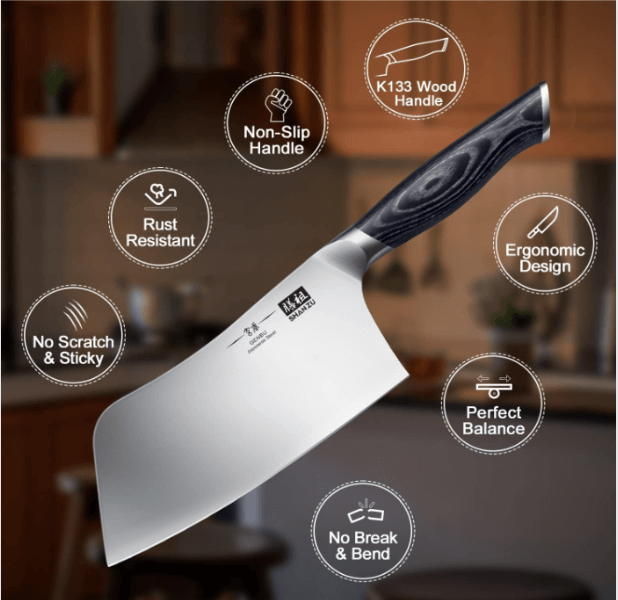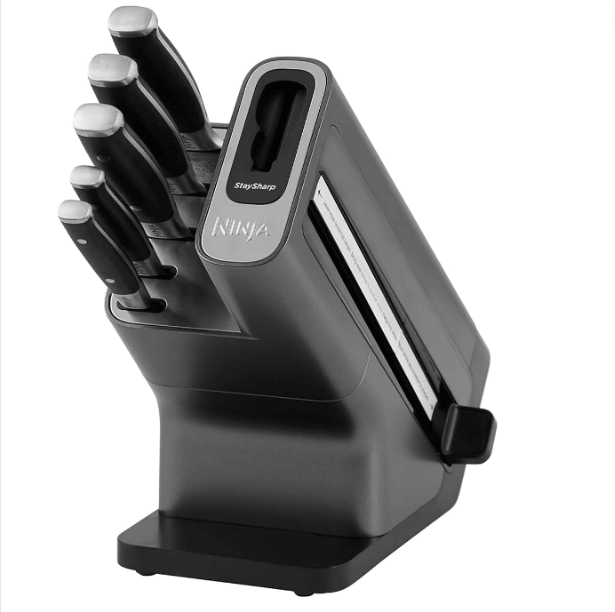7 Steps to Home Sausage Making Heaven
I made my first sausages! This is what I did – and what I learned…
I’m a newcomer to the world of homemade sausage making. My journey into crafting sausages at home is a mix of new discoveries and a rekindling of old skills. Here’s my detailed account of making my first batch of sausages, coupled with the lessons learned and memories revisited.
How I Made My First Home Made Sausage
My journey into sausage making began with a simple, yet determined approach. I focused on using good-quality meat, careful preparation, and patience. Here’s a breakdown of the process:
1. Selecting the Meat:
Opting for high-quality pork, I mixed pork shoulder and pork belly for a rich flavour and texture.
2. Preparing the Meat:
I cut the meat into manageable sizes for grinding, keeping an eye on the fat-to-meat ratio.
3. Grinding the Meat:
Using my trusty KitchenAid with a meat grinder attachment, I ground the meat. This stage was crucial in determining the texture of the sausages.
4. Seasoning and Mixing:
I added a blend of seasoning, iced water, and rusk to the ground meat. This step was about getting the flavour just right – a delicate balance of spices and textures.
5. Second Grinding:
To ensure even distribution of flavors and a finer texture, I ground the meat a second time.
6. Filling the Casings:
I then embarked on the task of filling the casings, a process that tested my patience and skill.
7. Cooking the Sausages:
Finally, the moment of truth – cooking and tasting my very own homemade sausages.
OK then, lets look at each of the 7 steps to sausage heaven in a little more detail!
1. Selecting Quality Meat:
I chose a blend of pork shoulder and pork belly, aiming for a slightly unconventional 75% meat to 25% fat ratio.
I know they say 70/30 split is good but my choice was influenced by a desire to experiment and see how it would impact the flavour and texture of the sausages. Remember all the flavours in the raw meat will carry over to the final sausages.
2. Preparing the Meat:
Cutting the meat into chunks suitable for grinding was a careful process. It was essential to get the size just right for effective grinding, ensuring a good texture for the sausages.

My Meat
3. First Grinding Phase:
As it’s my first time making sausage I wanted a simple way to start – we already have a KitchenAid so I used a meat grinder attachment to grind my meat together with some sausage filler attachments for making the sausages.
Learning to assemble and use it effectively was a significant step in my sausage-making journey.
In the grinder attachment box, you’ll find the main grinder body with a tray at the top, that leads down into the grinder area where the “worm” fits.
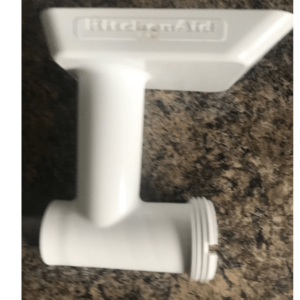
The KitchenAid Meat Grinder Tray
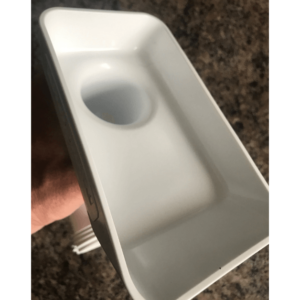
Down the hatch
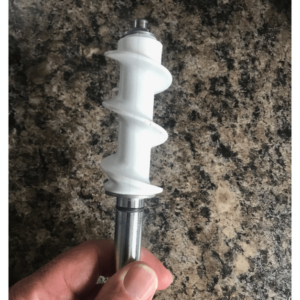
The KitchenAid Meat Grinder “Worm”
The worm pushes the meat to the grinder plates where it is cut using the blade and pushed through the grinder. There are 2 grinder plates included, one for coarse and one for fine grinds (I’ve already mislaid one!),

The KitchenAid Cutting Blade
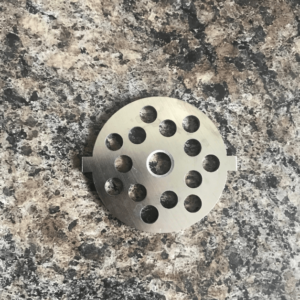
The KitchenAid Meat Grinder
Finally there is a food pusher to get the meat from the tray down to the worm to feed across to the blade and grinder plate.
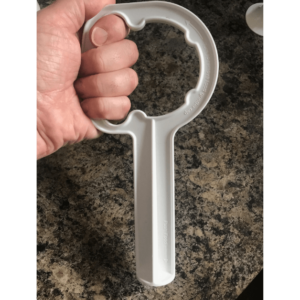
The KitchenAid Meat Pusher
Assembling this tool is quite straightforward. Begin by securing the grinder body onto the front of your KitchenAid Stand Mixer. Next, select your preferred grinding plate and attach it to the grinder body. For sausages, the coarse grind plate usually works best.
So once we have attached to the KitchenAid we can now proceed to feed the meat into the tray, here’s how it looked coming though:
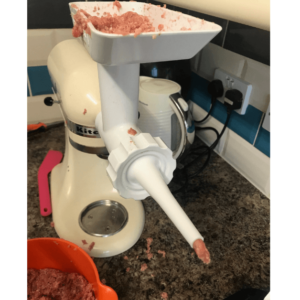
Ground meat and spillage
OTHER EQUIPMENT
In no particular order…
paper towels,
hand washing soap,
a sanitizing solution,
a scale,
Here is the scale I used, it was bought for my 14 year old son to help with his cooking. He makes great cakes…
If you’re like me and prefer the easiest shopping experience (i’m really lazy :-/), I just use Amazon. Its my go to for all sausage-making equipment. They’ve got everything you need, and it’s super easy to find and buy! For ease I’ve added links to the equipment I bought or had for my sausage making.
- cutting board,
- sharp knife,
- mixing bowls,
- measuring spoons,
- freezer bags to store my sausage
4. Seasoning the Mix:
After my first grind I added a blend of seasoning, iced water, and rusk to the ground meat. (l want to make my own seasoning in due course but was using some seasoning a friend gave me to get me started).
Cumberland Sausage Seasoning
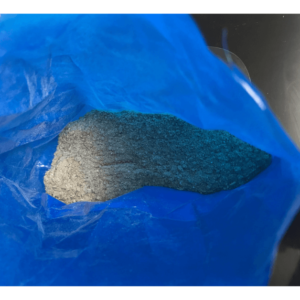
Its just seasoning…
My friend also gave me some rusk that is used to bind the ingredients together and give the sausages a good even texture.
The Rusk
I then added the iced water, this is used to maintain a low temperature which prevent the fat from “melting”.
It also creates a well-emulsified mixture for better sausage texture and flavour.
(Emulsified? Fat and water tend to separate or stay apart because they are not naturally compatible – rusk helps them mx together better!).
Iced Water
5. Second Grinding for Texture:
After mixing, I put the meat through a second grind. This was crucial for achieving a finer, more consistent texture, and it made a noticeable difference in the quality of the final product.
SAUSAGE INGREDIENTS
Now I did have the ingredients that I used:
Ingredients for my home made Cumberland Sausage
- 5 lb Lean Pork
- 2.5 lb Belly Pork
- 1/2 lb Bread Rusk
- 600ml Water
- ½ a packet of Seasoning
But I didn’t follow it to the letter – I thought this could be a mistake, however I have a confession to make.
About 30 years ago, I had a weekend job in a supermarket Butchery and one of my jobs was making sausage… I had a good idea therefore what the consistency of the mix should be.
I used my eye and some luck to get the mix to what I thought would be good for the sausages…
Next I’m ready to stuff the sausages.
Meats been Ground
My Stuffing Tubes
6. Stuffing the Casings:
Which Sausage Casing?
I used natural hog casings. My friend had come to the rescue again as he had given me some hog casings – enough he thought, for all the sausage I was going to make. As part of my prior planning, I had soaked the casings in water to remove some of the salt they are preserved in.
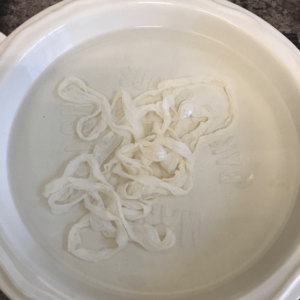
My Hog Casings
Once I’d rinsed the salt water away and replaced it with fresh water I started to rinse out the casings.
First I found the end of the casing, then opened it under a gently running tap allowed some cold water to run through.
I found it quite slippery to start with but after repositioning my bowl I found I could add more water into the casing that with the length of casing contained in a bowl.
I was able to move the casing so that the water flowed through to the other end. I did this 4 or 5 times so that the casing had a good rinse through.
The casing was then transferred onto the sausage stuffer that I had fitted to the kitchen aid attachment.
This goes in the place where the blade and grinder were so easy to remove them and fit the sausage stuffer in place.
The Mess!
This became the trickiest part of the process for me lol. I felt like I needed 3 or 4 hands…
I needed to feed the seasoned mix into the tray as well as push it down to be fed along the worm and out of the stuffer into the casings.
This really did take me some time, I couldn’t get enough mix into the stuffer to give a good feed through to the casings. I had to use 2 hands to plunge the meat into the machine and ended up making a bit of a mess on my bench top but…
I eventually got it done (well I say I – I enlisted the help of my wife for the extra 2 hands and we went there in the end! So by trial and error, (and with plenty of mess :-/).
I did manage to get the sausage casing stuffed – only to find that I had run out of casings. So again… my wife came to the rescue. She quickly made some pastry and we were able to make some sausage rolls out of some of the meat mixture.
Anyway – here is the finished roll of sausage and to be honest I am quite pleased with how they turned out!!
I was careful not to overstuff the casings and when it came to making individual sausages I squeezed a bit of sausage meat to make a gap in the casing and twisted it to get individual sausages. Again they looked pretty good to me!
My First Cumberland
Linked
7. Cooking the Sausages:
Finally, cooking and tasting my first homemade sausages was the most rewarding part. I was cautious to cook them evenly and ensure they were done to perfection.
We cooked half of these and froze the other half in their raw format. The remainder of the sausage mix we froze, I’ll make some breakfast patties or more sausage rolls with that in due course.
Before Frying
After Frying
I didn’t wait long to get a couple in the frying pan – I know it might be good to let them rest but they’re my first homemade sausages! (sorry about the burnt look of the pan).
I checked the temperature to make sure I’d cooked them enough – I know cooking sausages at home is pretty standard but with them being my fist homemade sausages I was cautious – not even sure why! And I just added them to a slice of bread as I wanted to taste them as quickly as I could – I know, it’s a bad photo, you can hardly see the sausage and doesn’t look great with the ketchup … but…but… they tasted absolutely bang on!

Bad Photo Of My Sausage Sarnie – Sorry
Just for completeness – here is how the sausage rolls came out (I’d eaten half of the one bottom right – couldn’t resist).
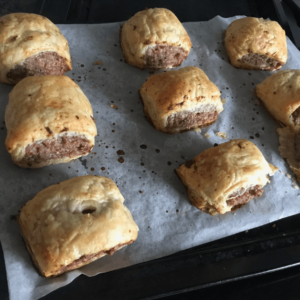
Cooked Sausage Rolls
Don’t Make so Much
Because the size of the tray in the kitchenaid grinder attachment can only take so much meat I might not make so much next time – or at least I know to have some patience and how long it will take – which reminds me, one thing I didn’t do was check the time, but I think that’s a good thing as it meant I was enjoying myself as the time flew by!
Overall I was pretty pleased with the kitchen aid attachment however cleaning it afterwards was tricky but I was patient and kept a good eye on each part to make sure all remnants were removed.
Hygiene
I can’t finish a write up without mentioning hygiene and what I did. To be honest I’m a bit of a hygiene freak :(. Anyway, I made sure I cleaned and sanitised all areas of the kitchen before I started, and then during where I could and after I had finished. I might have gone overboard but wanted to be safe, not sorry. I used a solution of diluted bleach water, approx a teaspoon in a gallon washing bowl. I just cleaned all the equipment with warm soapy water before making the sausage, then used some bleach / washing liquid to clean thoroughly afterwards.
Reflecting on the Journey
Looking back on the entire process, from selecting the meat to the final cooking, I realized the value of patience, precision, and creativity. It was a fulfilling experience, blending new learnings with old memories. The process was not just about making sausages but about connecting with a past passion and bringing it into my present kitchen.
My Final Thoughts…
I loved it. It wasn’t the industrial manufacture I remembered from years ago in that supermarket butchers. But getting your hands in and making something that you can enjoy tasting after is really satisfying. I have no doubt I’ll upgrade my equipment and bowls etc I’m using but I don’t think that’s needed. I was able to make home made sausages using a simple attachment to my kitchenaid and it did the job. I’m looking forward to trying more recipes!
